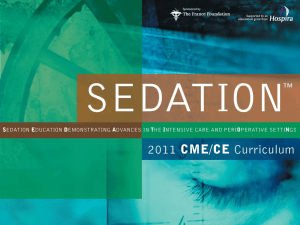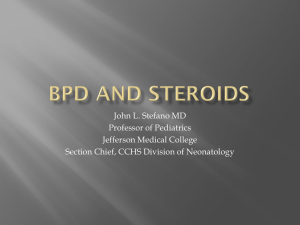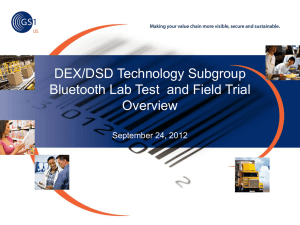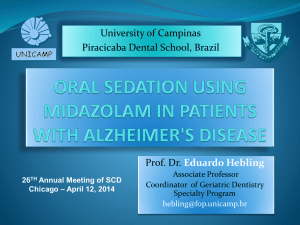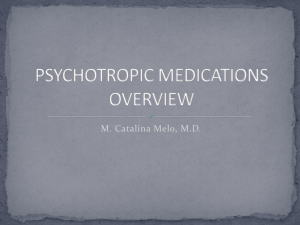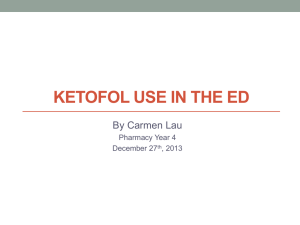slides 4.2 MB - SEDATION
advertisement
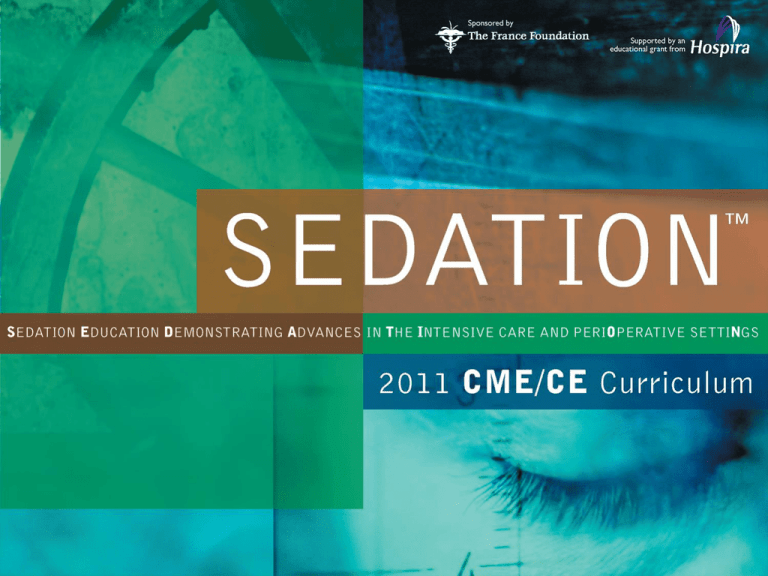
Assessing and Managing Sedation in the Intensive Care and the Perioperative Settings SEDATION Curriculum Learning Objectives • Manage adult patients who need sedation and analgesia while receiving ventilator support according to current standards and guidelines • Use validated scales for sedation, pain, agitation, and delirium in the management of these critically ill patients • Assess recent clinical findings in sedation and analgesia management and incorporate them into the management of patients in the acute care, procedural, and surgical sedation settings Desirable Properties for Sedatives in Neurological Surgery • • • • Preservation of intracranial hemodynamics Hemodynamic stability Noninterference with neurophysiologic monitoring Cooperative sedation (for functional neurosurgery) • Controllability (rapid onset and offset of effect) • Neuroprotection • Antinociception Potential Drawbacks of Sedative and Analgesic Therapy • • • • Oversedation Impede assessment of neurologic function Increase risk for delirium Numerous agent-specific adverse events Kollef MH, et al. Chest. 1998;114:541-548. Pandharipande PP, et al. Anesthesiology. 2006;104:21-26. Sedation in Volunteers Regional and Global CBF • 9 volunteers were infused with a 1 mcg/kg IV loading dose of dexmedetomidine, followed by an infusion of 0.2 mcg/kg/h and 0.6 mcg/kg/h • Measured hemodynamics and CBF (via PET scan) Prielipp RC, et al. Anesth Analg. 2002;95:1052-1059. Cerebral Blood Flow Baseline Low Infusion High Infusion 30 min posttermination • Dexmedetomidine infusion at 2 doses • Both low and high doses – Reduced global CBF by one third – Decreased mean systemic BP, HR, and CO 15% to 20% – Increased PaCO2 no more than 5 mm Hg Note: Color intensity correlates with CBF Prielipp RC, et al. Anesth Analg. 2002;95:1052-1059. • CBF reduced during infusion • Decreased CBF persisted at least 30 minutes Effects of Treatment on Hemodynamic Variables Baseline DEX load (20 min) LOW DEX HIGH DEX DEX off (30 min) 9 9 9 9 5 CO (L/min) 7.3 6.1* 6.3* 5.9* 6.0* MAP (mm Hg) 92 91 79* 81* 77* HR (bpm) 73 60* 65 62* 62* 7.39 NA 7.35* 7.35* 7.36* PaCO2 (mm Hg) 37 NA 42* 42* 39 PaO2 (mm Hg) 96 NA 98 96 98 [DEX] (pg/mL) 0.0 NA 466* 628* 380* Global CBF (mL · 100 g−1 · min−1) 90.5 NA 63.9* 60.6* 63.4* Variable n pH * P < 0.05, compared with baseline Prielipp RC, et al. Anesth Analg. 2002;95:1052-1059. Effect of Sedative on Global CBF Global CBF Treatment CBF CBF P value (mL · 100 g−1 · min−1) (95% CI) (vs baseline) Baseline 91 (72–114) DEX-LOW 64 (51–81) 0.0002 DEX-HIGH 61 (48–76) 0.0006 DEX-OFF 63 (49–83) 0.0120 Prielipp RC, et al. Anesth Analg. 2002;95:1052-1059. Cerebral Blood Flow Velocity, Cerebral Metabolic Rate, and Carbon Dioxide Response in Normal Humans • Hypothesis: dexmedetomidine would reduce the CBF/CMR ratio • Middle cerebral artery velocity was recorded continuously in 6 volunteers • CBFV and CMR were measured at 6 intervals before, during, and after DEX administration Drummond JC, et al. Anesthesiology. 2008;108:225-232. CBFV and CMRe Drummond JC, et al. Anesthesiology. 2008;108:225-232. Sedation Did Not Decrease CBFV/CMR Ratio • The expected decrease in CBFV was offset by an unanticipated decrease in CMR, leaving CBFV/CMR unchanged • Significant reduction in the slope of the PaCO2–CBFV relation during dex administration • Conclusion: dex should be further evaluated in patients with neurologic injury Drummond JC, et al. Anesthesiology. 2008;108:225-232. Brain Oxygenation Maintained in Neurovascular Surgery Patients Small Case Series • N = 5 patients • General anesthesia • Sufentanil • Sevoflurane • N2O • Dex at time = 0 *P < 0.04 from baseline Drummond JC, et al. J Neurosurg Anesthesiol. 2010;22(4):336-341. Intracranial Surgery Need for Sedation and Analgesia in Neurosurgical Patients • • • • • Prevent pain and anxiety Decrease oxygen consumption Decrease the stress response Patient-ventilator synchrony Avoid adverse neurocognitive sequelae – Depression, PTSD Rotondi AJ, et al. Crit Care Med. 2002;30:746-752. Weinert C. Curr Opin in Crit Care. 2005;11:376-380. Kress JP, et al. Am J Respir Crit Care Med. 1996;153:1012-1018. Double-Blind Randomized Controlled Trial: Intracranial Tumor Surgery • 54 patients scheduled for elective surgery of supratentorial brain tumor were randomized – Placebo – Dex, target plasma conc = 0.2 ng/mL – Dex, target plasma conc = 0.4 ng/mL • Dex groups received fentanyl 2 mcg/kg at induction and before the start of the operation; placebo group received 4 mcg/kg • Anesthesia maintained with NO2 in O2 and isoflurane Tanskanen PE, et al. Br J Anaesth. 2006;97(5):658-665. Hemodynamics Maximum increases from baseline **P < 0.01, DEX-0.4 vs DEX-0.2 and placebo ##P < 0.01, DEX-0.2 and DEX-0.4 vs placebo Tanskanen PE, et al. Br J Anaesth. 2006;97(5):658-665. Hemodynamics Intraoperative cardiovascular variability Dex increased median percentage of time points with SD and HR within 20% of comparison values Tanskanen PE, et al. Br J Anaesth. 2006;97(5):658-665. Randomized Controlled Trial of Sedation in IC Tumor Surgery • Dex infusion decreased hemodynamic responses to noxious stimuli and attenuated the emergence from anesthesia – Decreased the immediate hemodynamic response – Decreased the time to removal of the tracheal tube • However, the need to treat hypertension or tachycardia was similar in all groups • No difference between the groups in the occurrence of bradycardia or hypotension • At 2 hours after extubation, there was no difference in the Hudes class or subjective sedation score between the groups Tanskanen PE, et al. Br J Anaesth. 2006;97(5):658-665. Hemodynamics During Craniotomy • Double-blind, placebo-controlled study in patients undergoing intracranial surgery • Comparison of patients receiving either sevofluraneopioid-placebo anesthesia (n = 28) or sevofluraneopioid-dexmedetomidine anesthesia (n = 28) • Data collected: – Hemodynamic variables – systolic blood pressure (SBP) and heart rate (HR) – Administration of sevoflurane, opioids, and/or antihypertensive agents intraoperatively – Time spent in PACU and administration of opioids and/or antihypertensive agents postoperatively Bekker A, et al. Anesth Analg. 2008;107:1340-1347. Hemodynamics During Craniotomy No increase of hypotensive episodes or bradycardia Placebo (n = 28) Dexmedetomidine (n = 28) Median (IQR) Median (IQR) > 130 mmHg 35 (10-101) 9 (1-49)‡ < 90 mmHg 27 (8-58) 48 (10-96) > 90 bpm 12 (0-59) 8 (0-26) < 50 bpm 0 (0-2) 0 (0-4) Mean (SD) Mean (SD) SBP (mmHg) 106.5 (9.9) 102.2 (9.4) HR (bpm) 74.6 (13.0) 67.9 (1.7)‡ AUCSBP (mmHg×min/hr) AUCHR (beats×min/hr) Intraoperative Average ‡P < 0.05 Bekker A, et al. Anesth Analg. 2008;107:1340-1347. Hemodynamics During Craniotomy Placebo (n = 28) Dexmedetomidine (n = 28) 1.16 (0.38) 1.00 (0.37) Fentanyl, μg/kg 2.6 (1.9) 1.9 (1.0) Remifentanil, μg/kg 27 (13) 19(11)* Any BP med, n (%) 24 (86%) 12 (43%)† PACU duration (min) 130 (27) 91 (17)‡ Times SBP > 130 mmHg 2.5 (2.0) 1.25 (1.55)* Any analgesic, n (%) 18 (64%) 15 (54%) Any BP med, n (%) 14 (50%) 10 (36%) Intraoperative Drugs Sevoflurane, mean (%ET) Postoperative Measures *P < 0.05 compared with placebo †P = 0.0008 compared with placebo ‡P < 0.0001 compared with placebo Bekker A, et al. Anesth Analg. 2008;107:1340-1347. NeurolCU Managing Traumatic Brain Injury • • • • • • • • • Monitor ICP Diagnosis Urgent surgery when indicated Blood pressure management Hyperosmolar therapy (mannitol, hypertonic saline) Sedation/analgesia Nutrition DVT prophylaxis Prevention of seizure Saiki RL. Crit Care Nurs Clin North Am. 2009;21:549-559. Sedation/Analgesia for Traumatic Brain Injury Goal: reduce ICP by decreasing pain, agitation Agent Advantages Considerations Propofol • Short acting • Reduces cerebral metabolism, O2 consumption • Improves ICP after 3d • Propofol infusion syndrome Barbiturates • Reduce ICP • Neuroprotection • Interfere with neuro exam • Hypotension, reduced CBF • OCs not improved with severe TBI Saiki RL. Crit Care Nurs Clin North Am. 2009;21:549-559. Traumatic Brain Injury with Reduced PbtO2 Medical Interventions Bohman LE, et al. Neurocrit Care. 2011;14:361-369. Traumatic Brain Injury with Reduced PbtO2 Response Rate/ Overall Patient Response Rate Effectiveness of Interventions Benefit of PbtO2 not proven Bohman LE, et al. Neurocrit Care. 2011;14:361-369. Monitoring ICP After TBI • Retrospective analysis • 246 TBI patients • Classify ICP profiles by time to peak • Correlate with outcomes Bremmer R, et al. Neurocrit Care. 2010;12:362-368. 1-2 d peak 3-5 d peak >5 d peak Monitoring ICP After TBI Bremmer R, et al. Neurocrit Care. 2010;12:362-368. Awake Craniotomy Functional Neurosurgery Awake Craniotomy Procedures Bilotta F, et al. Curr Opin Anaesthesiol. 2009;22(5):560-565. Characteristics of Cooperative Sedation • Patients easily transition from sleep to wakefulness and task performance when aroused • Patients can resume rest when not stimulated • Most useful during procedures in which communication with the patient must be maintained, facilitates patient participation in therapeutic maneuvers • Reduces risk of drug-induced complications Bekker A, et al. Neurosurgery. 2005;57(1 Suppl):1-10. Current Sedatives for Awake Craniotomy Bonhomme V, et al. Eur J Anaesthesiol. 2009;26(11):906-912. Asleep-Awake-Asleep Overview Anesthesia Surgical Preparation Cooperative Sedation Eloquent Area Mapping Surgery Anesthesia Surgical Closure Sedation During Awake Craniotomy Is Dex Compatible With Neurocognitive Testing? Patient Number Indication Dex Load, μg/kg Bekker 2001 Bustillo 2002 Lotto 2003 Ard 2003 Ard 2005 1 5 11 2 17 Neoplasm AVM Tumor, epilepsy, aneurysm Pediatric epilepsy Tumor, epilepsy 1 0 or 1 1 0.5 0.81 3.4 1.6 0.2–0.7 0.6 2.8 1 Mean Dex Dose, μg/kg Dex Infusion, μg/kg.h 0.4, 0.2, 0.1 Mean MDZ, mg Mean Fentanyl, μg Other Anesthesia Cognitive Test Test successful? 100 160 Prop, N2O, sevo (flumazenil) Language 1/1 0.5, 0.2, 0.1 0.1–0.4 1.7 (in 6 pts) 100 191 (in 16 pts) Prop Prop, N2O, sevo Prop, N2O, sevo Wada Language Language Language 0/5 10/11 2/2 17/17 Bekker AY, et al. Anesth Analg. 2001;92(5):1251-1253. Bustillo MA, et al. J Neurosurg Anesthesiol. 2002;14(3):209-212. Lotto M, et al. Anesthesiology. 2003; 99: A356. Ard J, et al. J Neurosurg Anesthesiol. 2003;15(3):263-266. Ard JL, et al. Surg Neurol. 2005;63(2):114-116. AVM = arteriovenous malformation Prop = propofol Sevo = sevoflurane Implanting DBS for PD • Sedation is demanding – – – – Recordings of movement-related neurons Preservation of PD symptoms for DBS localization Patient cooperation Halo restricts movement, respiratory depression problematic • GABAergic sedatives (MDZ, propofol) not useful – Ameliorate tremor and rigidity (precludes mapping & testing) – Impair consciousness – May cause respiratory depression Rozet I, et al. Anesth Analg. 2006;103(5):1224-1228. Implanting DBS for PD • Retrospective study with dexmedetomidine – Control (no sedative) n = 8 patients – Dex (0.1-0.3 mcg/kg.h, more to goal [OAA/S = 4]) n = 11 patients • Results – MER unimpaired by dex – Surgical time shorter with dex (4 vs 6 h, P = 0.05) – Less intraoperative use of antihypertensives (100% vs 54%, P = 0.048) – Dex preserved clinical signs of PD • Tremor • Rigidity • Bradykinesia • Study limitations – Small – Observational – Only perioperative outcomes presented Rozet I, et al. Anesth Analg. 2006;103(5):1224-1228. Implanting DBS (2) • • • • Retrospective analysis of 258 procedures (250 patients) Patients with motor disorders, 68% PD Propofol most common sedative, 91% Propofol used almost exclusively in the first 30 to 45 minutes to facilitate head-frame placement Khatib R, et al. J Neurosurg Anesthesiol. 2008;20:36-40. Conscious Sedation for Glioma Resection? • Retrospective cohort-matched study • Initial and final surgery with propofol/sevoflurane • Dex with prn midazolam during resection Peruzzi P, et al. J Neurosurg. 2011;114(3):633-639. Monitoring EEG in Patients with Temporal Lobe Epilepsy Oda Y, et al. Anesth Analg. 2007;105(5):1272-1277. Talke P, et al. J Neurosurg Anesth. 2007;19(3):195-199. Spinal Surgery/AFOI Drugs for Fiberoptic Intubation Agent Class Example Advantages Considerations GABA agonist Benzodiazepine Midazolam • Quick onset • Injection not painful • Short duration • Not analgesic • Airway reflexes persist GABA agonist Benzodiazepine Propofol • Quick onset • Respiratory depression • Unconsciousness • Decreased bp, cardiac output • Increased HR Opioid Fentanyl Remifentanil • Analgesic • Cough suppressive • Respiratory depression a2 Agonist Dexmedetomidine • Pt easily arousable • Anxiolytic • Analgesic • No respir. depression • Transient hypertension • Hypotension • Bradycardia Summary courtesy of Pratik Pandharipande, MD. Propofol vs Combined Sedation in Flexible Bronchoscopy • Randomized non-inferiority trial • 200 diverse patients received propofol or midazolam/hydrocodone • 1o endpoints – Mean lowest SaO2 – Readiness for discharge at 1h • Result – No difference in mean lowest SaO2 – Propofol group had Higher readiness for discharge score (P = 0.035) Less tachycardia Higher cough scores • Conclusion: Propofol is a viable alternative to midazolam/hydrocodone for FB Stolz D, et al. Eur Respir J. 2009;34:1024-1030. Dexmedetomidine Increases Comfort in AFOI Double-blinded randomized trial Midazolam +/- dexmedetomidine Awake fiberoptic intubation (AFOI) Patient comfort rated by 2 observers Total Comfort Score (max = 35) • • • • n = 24 n = 31 Preoxygenation Introduction of scope Bergese SD, et al. J Clin Anesth. 2010;22(1):35-40. Introduction of ET tube Sedation for AFOI Study Design 1 • Phase 3 multicenter study comparing Dex with placebo (Pbo) in the sedation of nonintubated patients with anticipated difficult-to-intubate airways who were undergoing AFOI • Patients randomized – Dex 1 μg/kg loading dose (10 min) and 0.7 μg/kg/hr maintenance infusion – Pbo in normal saline • After topical anesthesia (lidocaine) and a Ramsay Sedation Scale (RSS) score ≥ 2 was achieved, nasal or oral intubation using a flexible fiberoptic bronchoscope was performed Bergese SD, et al. Am J Ther. 2010;17(6):586-595. Sedation for AFOI Study Design 2 • MDZ was administered as required as rescue medication for patients with a RSS score = 1 until target RSS score ≥ 2 • Primary endpoint: percentage of patients requiring rescue MDZ to achieve and/or maintain a target sedation level (RSS score ≥ 2) Bergese SD, et al. Am J Ther. 2010;17(6):586-595. Sedation for AFOI Results • Significantly fewer patients in the Dex group required rescue MDZ to achieve and/or maintain sedation compared with the Pbo group – 47.3% vs 86.0%, P < 0.001 • The total mean supplemental MDZ dose required was significantly lower in Dex-treated patients than in Pbotreated patients – 1.07 mg vs 2.85 mg, P < 0.001 • Blood pressure was the most often reported AE – 27% of the Dex group had hypotension – 28% of the placebo group had hypertension Bergese SD, et al. Am J Ther. 2010;17(6):586-595. Sedation for AFOI MDZ Use 100 90 14% 53% Patients (%) 80 86% 70 Did Not Require MDZ 60 Required MDZ 50 40 47%* 30 20 10 0 Mean MDZ Dose 1.07 mg % patients receiving MDZ and mean dose both P < 0.001 Dexmedetomidine (n = 55) Bergese SD, et al. Am J Ther. 2010;17(6):586-595. Mean MDZ Dose 2.85 mg Placebo (n = 50) Sedation for AFOI Conclusions • Compared to placebo, Dex reduced MDZ requirement in patients with high-risk airways undergoing AFOI – Fewer Dex patients received MDZ – Dex patients requiring MDZ received a lower mean dose • Dex is a viable choice for sedation of patients requiring AFOI Bergese SD, et al. Am J Ther. 2010;17(6):586-595. SSEP Amplitude and MEP Voltage SSEPs: posterior tibial nerve (P37) median nerve (N20) Bala E, et al. Anesthesiology. 2008;109(3):417-425. MEPs: dorsal interossei abductor hallucis longus Median Nerve SSEPs Tracings Case Report Baseline Left Instrumentation/propofol Closure/dex Baseline Right Instrumentation/propofol Closure/dex Bloom M, et al. J Neurosurg Anesth. 2002;13(4):320-322. Does Sedation Attenuate tceMEP? • • • • Subjects Procedure Anesthesia/analgesia Primary endpoint 44 patients with idiopathic scoliosis Posterior spine fusion surgery N2O, sevoflurane, fentanyl, MDZ, remifentanil Amplitude of transcranial electric motorevoked potential (tceMEP) • Treatment Groups Mahmoud M, et al. Anesthesiology. 2010;112(6):1364-1373. Does Sedation Attenuate tceMEP? • 14/40 Dex subjects experienced reduction of tceMEP amplitude (≥ 3/4 muscles affected) – Mean time to recovery (≥ 70% of baseline) = 68 min • Dex main effect significant in FDI and TA (P = 0.015 and 0.012) • Propofol main effect not significant Percent Change from Baseline in tceMEP Amplitude Mahmoud M, et al. Anesthesiology. 2010;112(6):1364-1373. Does Sedation Attenuate tceMEP? • Attenuation of tceMEP varied with Dex dose – High and intermediate group 11/23 (48%) – Low group 2/17 (12%) P < 0.025 • Increasing the target level of propofol from 2.5 to 5 μg/ml without increasing the level of Dex had no significant effect on the amplitude of the tceMEPs • Propofol–Dex interaction was not significant • Study limited by early termination, only loading phase analyzed Conclusions • Dex can be used as an adjunct to remifentanil-propofol total IV anesthesia when tceMEP and SSEP monitoring is required • Target plasma concentrations of 0.4 ng/ml Dex and 2.5 μg/ml propofol seem to have minimal effect on tceMEP amplitude Mahmoud M, et al. Anesthesiology. 2010;112(6):1364-1373. Neurosurgery Summary • Neurosurgery presents special challenges for sedation – Preserve cerebral hemodynamic stability – Maintain patient consciousness for some procedures • Oversedation presents risks – Delirium – Increased ICU LOS – Lack of patient interaction during procedure • Emerging combinations of anesthetic and sedative compounds have attractive properties for addressing these unique requirements

